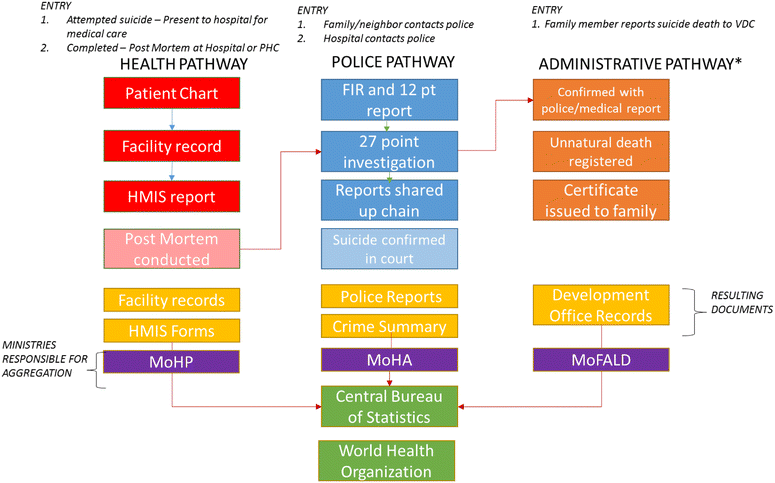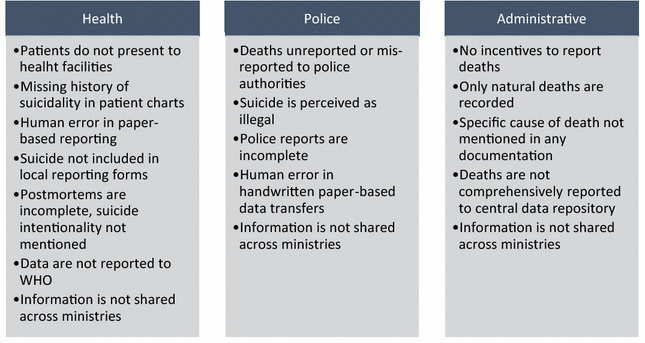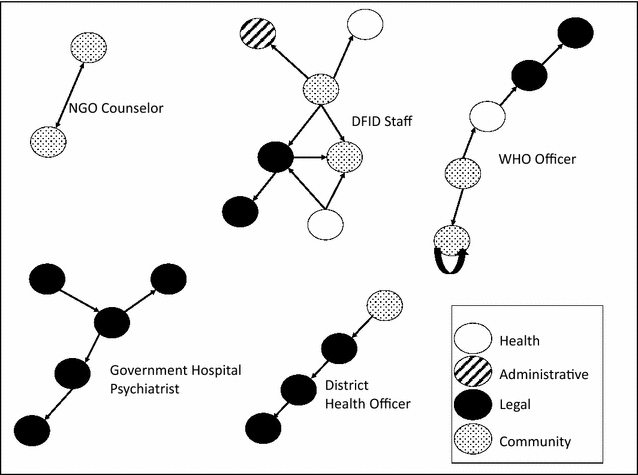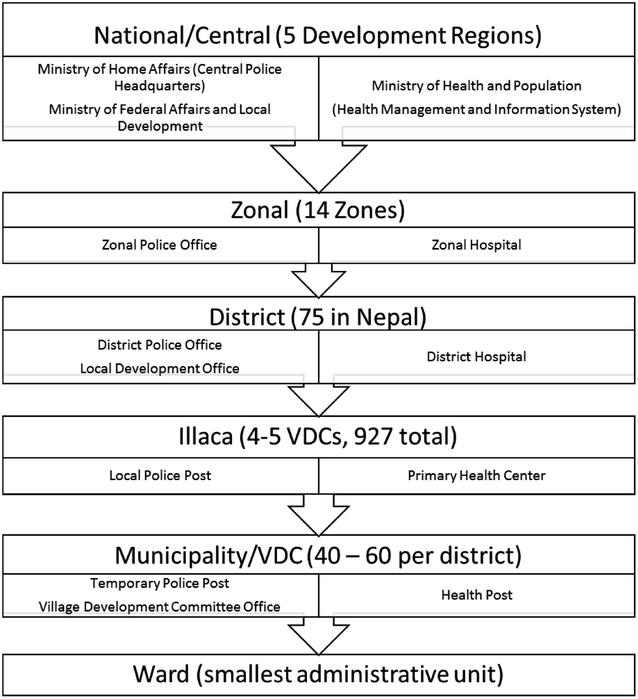Suicide surveillance and health systems in Nepal: a qualitative and social network analysis
- PMID: 27274355
- PMCID: PMC4895957
- DOI: 10.1186/s13033-016-0073-7
Suicide surveillance and health systems in Nepal: a qualitative and social network analysis
Abstract
Background: Despite increasing recognition of the high burden of suicide deaths in low- and middle-income countries, there is wide variability in the type and quality of data collected and reported for suspected suicide deaths. Suicide data are filtered through reporting systems shaped by social, cultural, legal, and medical institutions. Lack of systematic reporting may underestimate public health needs or contribute to misallocation of resources to groups most at risk.
Methods: The goal of this study was to explore how institutional structures, cultural perspectives on suicide, and perceived criminality of self-harm influence the type and quality of suicide statistics, using Nepal as an example because of its purported high rate of suicide in the public health literature. Official documentation and reporting networks drawn by police, policy makers, and health officials were analyzed. Thirty-six stakeholders involved in various levels of the death reporting systems in Nepal participated in in-depth interviews and an innovative drawn surveillance system elicitation task.
Results: Content analysis and social network analysis revealed large variation across the participants perceived networks, where some networks were linear pathways dominated by a single institution (police or community) with few nodes involved in data transmission, while others were complex and communicative. Network analysis demonstrated that police institutions controlled the majority of suicide information collection and reporting, whereas health and community institutions were only peripherally involved. Both health workers and policy makers reported that legal codes criminalizing suicide impaired documentation, reporting, and care provision. However, legal professionals and law review revealed that attempting suicide is not a crime punishable by incarceration. Another limitation of current reporting was the lack of attention to male suicide.
Conclusions: Establishment and implementation of national suicide prevention strategies will not be possible without reliable statistics and comprehensive standardized reporting practices. The case of Nepal points to the need for collaborative reporting and accountability shared between law enforcement, administrative, and health sectors. Awareness of legal codes among health workers, in particular dispelling myths of suicide's illegality, is crucial to improve mental health services and reporting practices.
Keywords: Developing countries; Health systems; Law enforcement; Nepal; Policy; Suicide; Suicide detection; Vital surveillance.
Figures




Similar articles
-
Surveillance for Violent Deaths - National Violent Death Reporting System, 42 States, the District of Columbia, and Puerto Rico, 2019.MMWR Surveill Summ. 2022 May 20;71(6):1-40. doi: 10.15585/mmwr.ss7106a1. MMWR Surveill Summ. 2022. PMID: 35588398 Free PMC article.
-
Perception of the criminality of attempted suicide in Nepal and its impact on suicide reporting.Int J Law Psychiatry. 2022 Jul-Aug;83:101796. doi: 10.1016/j.ijlp.2022.101796. Epub 2022 May 17. Int J Law Psychiatry. 2022. PMID: 35594745
-
Surveillance for Violent Deaths - National Violent Death Reporting System, 48 States, the District of Columbia, and Puerto Rico, 2020.MMWR Surveill Summ. 2023 May 26;72(5):1-38. doi: 10.15585/mmwr.ss7205a1. MMWR Surveill Summ. 2023. PMID: 37220104 Free PMC article.
-
Tuberculosis.In: Holmes KK, Bertozzi S, Bloom BR, Jha P, editors. Major Infectious Diseases. 3rd edition. Washington (DC): The International Bank for Reconstruction and Development / The World Bank; 2017 Nov 3. Chapter 11. In: Holmes KK, Bertozzi S, Bloom BR, Jha P, editors. Major Infectious Diseases. 3rd edition. Washington (DC): The International Bank for Reconstruction and Development / The World Bank; 2017 Nov 3. Chapter 11. PMID: 30212088 Free Books & Documents. Review.
-
Police-related triage interventions for mental health-related incidents: a rapid evidence synthesis.Southampton (UK): NIHR Journals Library; 2019 May. Southampton (UK): NIHR Journals Library; 2019 May. PMID: 31162918 Free Books & Documents. Review.
Cited by
-
Tracking progress in suicide prevention in Indigenous communities: a challenge for public health surveillance in Canada.BMC Public Health. 2018 Nov 27;18(1):1320. doi: 10.1186/s12889-018-6224-9. BMC Public Health. 2018. PMID: 30482175 Free PMC article.
-
Identification of research priorities for suicide prevention in Nepal: a Delphi study.BMC Psychiatry. 2022 Jun 25;22(1):429. doi: 10.1186/s12888-022-04074-z. BMC Psychiatry. 2022. PMID: 35752774 Free PMC article.
-
Validation of a brief sex addiction screening instrument (PATHOS) and prediction of sex addiction in the Iranian population.Trends Psychiatry Psychother. 2021 Jan-Mar;43(1):30-36. doi: 10.47626/2237-6089-2019-0088. Trends Psychiatry Psychother. 2021. PMID: 33681904 Free PMC article.
-
Evaluation of the collaborative integrated surveillance system (ViCo) in Guatemala: a qualitative study on lessons learned and future perspectives.BMC Public Health. 2022 Feb 18;22(1):350. doi: 10.1186/s12889-022-12719-7. BMC Public Health. 2022. PMID: 35183153 Free PMC article.
-
Suicide and deliberate self-harm among women in Nepal: a scoping review.BMC Womens Health. 2021 Dec 9;21(1):407. doi: 10.1186/s12905-021-01547-3. BMC Womens Health. 2021. PMID: 34886837 Free PMC article.
References
-
- World Health Organization. Suicide rates per 100,000 by country, year and sex (Table). 2011.
-
- World Health Organization. Preventing suicides: a global imperative. 2014.
-
- World Health Organization. Mental health action plan 2013–2020. 2013.
-
- Thacker SB, Qualters JR, Lee LM. Public health surveillance in the United States: evolution and challenges. MMWR. 2012;61(Suppl):3–9. - PubMed
Grants and funding
LinkOut - more resources
Full Text Sources
Other Literature Sources

